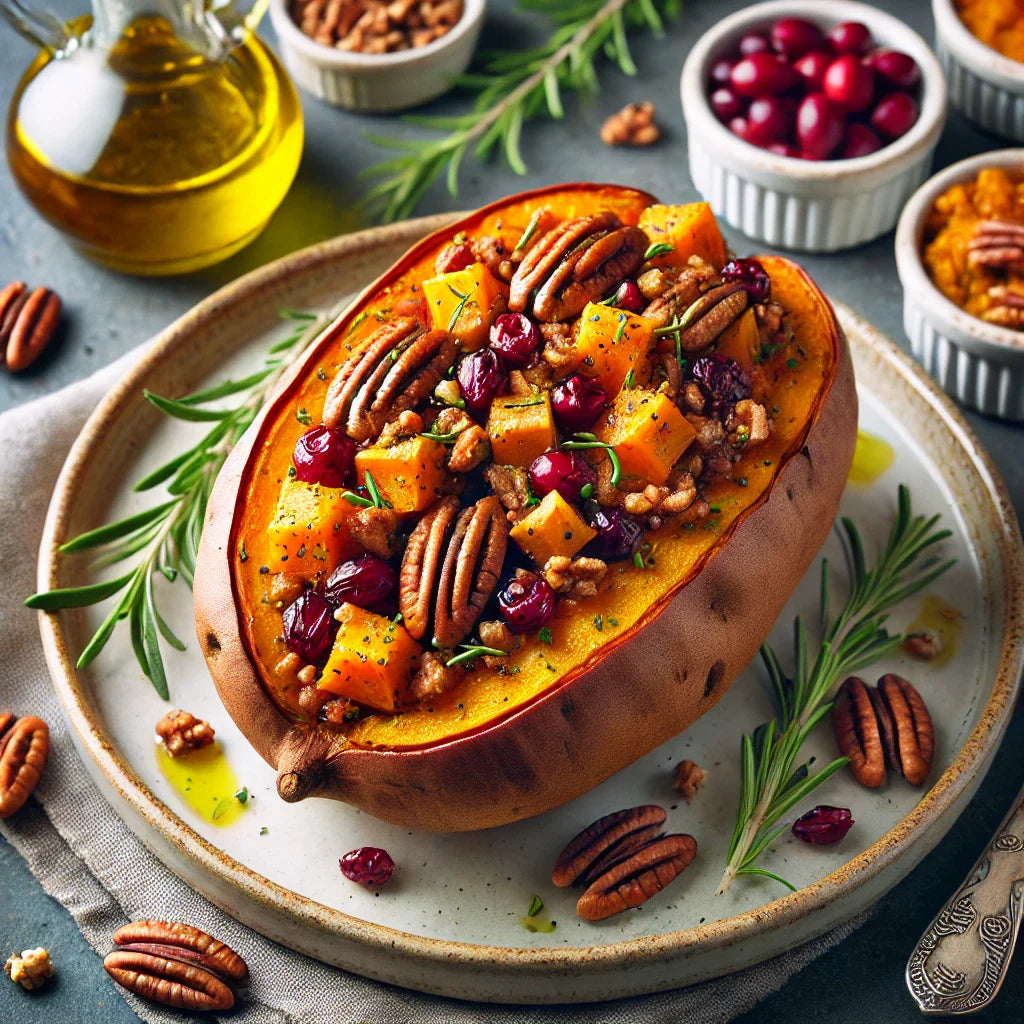
Twice Baked Sweet Potato: Food for Longevity
Share
Potatoes have been a staple of the American diet for a quite some time now, but it's unrelated neighbor the sweet potato was typically reserved for Thanksgiving. These two "potatoes" are quite different. Let's dive into what makes the sweet potato a Blue Zone favorite and why you should incorporate more of it into your life.
Sweet Potatoes: A Nutritional Powerhouse Worth Exploring

Botanical Classification:
- White potatoes, also known as Irish potatoes, belong to the Solanaceae family, which includes tomatoes, eggplants, and peppers. They are tubers of the plant Solanum tuberosum.
- Sweet potatoes are from the Convolvulaceae family, making them a part of the morning glory group. They are the storage roots of the plant Ipomoea batatas.
Nutritional Content:
- White potatoes are high in carbohydrates and provide a good source of vitamin C, potassium, and vitamin B6. They have a higher glycemic index compared to sweet potatoes, which means they can cause a quicker spike in blood sugar levels.
- Sweet potatoes are rich in beta-carotene, which the body converts into vitamin A. They also offer vitamin C, potassium, and fiber, with a lower glycemic index than white potatoes. This means they provide a more gradual rise in blood sugar levels, making them a preferred option for managing blood sugar.
Taste and Texture:
- White potatoes have a neutral, starchy taste and are very versatile in cooking. They can be baked, mashed, fried, and used in a variety of dishes. Depending on the variety, their texture can range from waxy to fluffy, suitable for different culinary uses.
- Sweet potatoes have a naturally sweet taste and a creamy texture when cooked. They are often baked, roasted, or mashed and can be used in both savory and sweet dishes due to their flavor profile.
Culinary Uses:
- White potatoes are often used in dishes like mashed potatoes, french fries, potato salads, and soups.
- Sweet potatoes are commonly found in casseroles, pies, soups, and as roasted side dishes. Their natural sweetness makes them a popular ingredient in desserts and sweet treats as well.
Craving a meal with the same comforting flavors as Twice Baked Sweet Potato but without the effort? Our Butternut Lentil Bisque is here for you! Packed with warming spices, hearty butternut squash, and wholesome ingredients, it’s the perfect way to nourish your body and satisfy your taste buds.
As you can see there are quite a few differences! We love sweet potatoes because they are rich in vitamins A and C, manganese, fiber, and antioxidants, sweet potatoes are a staple in Mediterranean cuisine for their ability to support heart health, improve digestion, and reduce inflammation. Our Twice Baked Sweet Potato recipe incorporates ingredients like olive oil, garlic, spinach, and feta cheese, enhancing the natural sweetness of the potatoes while adding layers of flavor and nutritional value typical of the Mediterranean diet.
The Mediterranean diet emphasizes the consumption of plant-based foods, minimization of meat intake, and reliance on fresh, locally sourced ingredients. The "Twice Baked Sweet Potatoes" recipe embodies these principles, offering a dish that is both environmentally friendly and conducive to long-term health.
Have you seen the Netflix docu-series "Living to 100?" if not it explores the diets of some of the world's longest-lived populations in what is called Blue Zones. Notably, it references how these communities, particularly in regions like Okinawa, Japan, incorporate sweet potatoes into their daily diet as a cornerstone of their longevity. The series suggests that the regular consumption of sweet potatoes, a low-glycemic index food rich in complex carbohydrates and dietary fiber, contributes significantly to these populations' impressive life spans and low rates of chronic diseases. So why not try our "Twice Baked Sweet Potatoes" recipe and integrate some longevity nutrition into your life. Enjoy!

What you'll need:
- 1 small Honey Nut or (1 cup Butternut Squash)
- 1 small Delicata Squash
- 2 medium Sweet Potatoes
- 1 Tbsp Avocado Oil
- ½ tsp sea salt
- 1 large Fuji Apple, peeled, cored, and diced
- ½ cup Dried Cranberries (unsweetend)
- 2 Tbsp Apple Cider Vinegar
- 1 Tbsp Brown Mustard Seed
- 1 tsp Ground Coriander
- 1 Bay Leaf
- 1 Cinnamon Stick
- 2 slices peeled fresh Ginger
- Filtered Water
- Salt and Pepper to taste
- 2 Tbsp Avocado Oil
- ¼ Cup Chopped Pecans (raw or toasted)
How to make them:
- Preheat oven to 400
- Cut off ends of both squash, halve and scrape seeds and pulp out.
- Wash sweet potato and dry.
- Rub squashes in avocado oil and place cut side down on a foil lined baking sheet. Rub potatoes in oil and sea salt and prick with a fork. Place potatoes on a baking sheet with squash.
- Roast for 40-60 minutes or until squash and potatoes are tender (this will vary depending on size). We use a cake tester to see how easily it penetrates the vegetables. Once soft, remove from the oven and allow to cool. Reduce oven to 350 degrees
- While Roasting, in a saucepan bring apple, cranberries, vinegar, mustard seed, coriander, bay leaf, cinnamon, and ginger with enough water to almost cover to a boil and let simmer until apples are soft.
- Remove, bay leaf, ginger, and cinnamon stick
- Scrape squash into a large bowl (removing the skins). Halve the potatoes lengthwise and scrape the insides into the bowl with the squash. Be sure to leave a little bit of potato in the skin. Mash squash and potato with 2 Tbsp of Avocado Oil
- Add apple and cranberry mixture to the squash and potatoes and mash all together. Season to taste.
- Stuff Potato skins with mixture and drizzle of olive oil and Chopped Pecans
- Bake in a 350 degree oven for 10-15 minutes to heat through.
We love your feedback so reach out to us on instagram, by email at info@organicpharmer.com or comment below!
